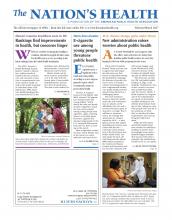Electronic cigarettes pose a significant risk to youth and young adults, according to a new surgeon general’s report that recommends actions to protect their health.
On Dec. 8, Surgeon General Vivek Murthy, MD, MBA, released “E-Cigarette Use Among Youth and Young Adults,” which details the risks and trends around e-cigarettes, which are now more popular among young people than cigarettes, cigars, chewing tobacco or hookah pipes. Electronic cigarette use among young people in the U.S. increased 900 percent from 2011 to 2015, according to the report.
Most e-cigarettes contain nicotine, which Murthy said in the report can cause addiction and harm developing brains. The report also outlines what is unknown about e-cigarettes, noting gaps in scientific evidence.
“This report is being issued while these products and their patterns of use continue to change quickly,” Murthy said in the report’s preface. “However, although e-cigarettes generally emit fewer toxicants than combustible tobacco products, we know that aerosol from e-cigarettes is not harmless.”
The term e-cigarette encompasses a variety of products, but all work the same way: Users inhale an aerosol, usually containing nicotine — which comes from tobacco — along with flavorings and other additives, according to the report.
U.S. Department of Health and Human Services data show that cigarette smoking among young people has declined “markedly” over the past decades, but e-cigarette use has grown exponentially, surpassing cigarette smoking in 2014. Data from the Centers for Disease Control and Prevention, shared in the report, shows that nearly 40 percent of high school students had tried e-cigarettes in 2015, up from just 5 percent in 2011. Almost no middle schoolers had tried e-cigarettes in 2011, but more than 10 percent had by 2015.
More than 3 million youth in middle and high school had reported using e-cigarettes in the past month in 2015.
Regular use levels were also cause for concern, according to the report. The National Adult Tobacco Survey, in its 2013-14 data, showed that while 9.58 percent of 18- to 24-year-olds smoke cigarettes only, a growing number, 6.1 percent, use e-cigarettes — and 7.47 percent use both, despite many people reporting that they chose to use e-cigarettes to stop smoking traditional tobacco cigarettes, as they believe the aerosol contains fewer toxicants than tobacco products that require a lighter.
However, e-cigarette vapor is far from harmless water vapor, the report said, but in fact contains many compounds that are harmful to health.
“E-Cigarette Use Among Youth and Young Adults” is not the first surgeon general’s report on smoking. In 1964, Surgeon General Luther Terry, MD, issued “Smoking and Health: Report of the Advisory Committee of the Surgeon General of the Public Health Service,” the first surgeon general’s report, which provided scientific evidence linking tobacco use to many public health issues, including cancer, respiratory diseases and cardiovascular disease.
In 2014, acting Surgeon General Boris Lushniak, MPH, MD, an APHA member, issued an update for the 50-year anniversary of the report that charted progress made in reducing tobacco use and its health impacts over the past half-century.
The 2016 report builds on federal efforts to protect public health from the risks associated with e-cigarettes, particularly for young people, as more young people use e-cigarettes than people 25 and older as well. The Family Smoking Prevention and Tobacco Control Act of 2009 gave the U.S. Food and Drug Administration the power to regulate the manufacturing, distribution and marketing of e-cigarettes, including enforcing age restrictions.
HHS Secretary Sylvia Burwell, in a message about the 2016 report, said each step forward in the regulation and study of e-cigarettes was a step “to protect America’s youth.”
“We have more to do to help protect Americans from the dangers of tobacco and nicotine, especially our youth,” Burwell said. “The findings from this report reinforce the need to support evidence-based programs to prevent youth and young adults from using tobacco in any form, including e-cigarettes. The health and well-being of our nation’s young people depend on it.”
Public health leaders and organizations commended Murthy and the report. In a Dec. 8 statement, Matthew Myers, JD, president of the Campaign for Tobacco-Free Kids, said the report was a “clear and unmistakable message to our nation’s policymakers: E-cigarettes pose a serious threat to the health of kids and young adults, and we should be doing everything we can to prevent young people from using these products.”
Myers also noted that the report confirmed that it is no coincidence that e-cigarettes are popular among children and young adults. E-cigarette vapor is often marketed with sweet flavors — a leading reason for using them, according to youth surveyed in multiple studies. And the surgeon general’s report pointed to e-cigarette marketing themes, such as sex and customer satisfaction, as being the same that were used to market conventional cigarettes to young people.
The new surgeon general report offered potential policies that could prevent youth e-cigarette use, such as including e-cigarettes in antismoking policies, raising prices and taxes on products and requiring e-cigarette retailers to have a license to sell them. The report also includes a call to action for public health advocates to reduce the threat to young people.
The report calls on health supporters to:
do no harm, by including e-cigarettes in policies, based in evidence-based messaging, that will reduce risks;
provide information about e-cigarette dangers among young people;
continue to regulate e-cigarettes at the federal level;
promote programs and policies at the state and local levels to prevent young people from using e-cigarettes;
curb advertising for e-cigarettes directed at young people; and
expand surveillance, research and evaluation related to e-cigarettes.
Progress is already being made in achieving some of the goals set out in the report. In August, FDA started to enforce a ban on vending machine sales of e-cigarettes unless the machines are in adult-only facilities, as well as a ban on free samples and sale of e-cigarettes to minors.
The American Heart Association commended the report and its recommendations. In a Dec. 8 news release, CEO Nancy Brown said the report helps to illustrate that “the use of tobacco by our young people — no matter what form it takes — demands our urgent attention.
“The actions we take today will help protect young lives from being tragically lost to cardiovascular disease — our nation’s No. 1 killer,” Brown said.
APHA has free resources health workers can use to fight tobacco use at the national and local levels. Visit www.apha.org/ tobacco for information.
To read the surgeon general’s report, visit https://e-cigarettes.surgeongeneral.gov.
- Copyright The Nation’s Health, American Public Health Association












